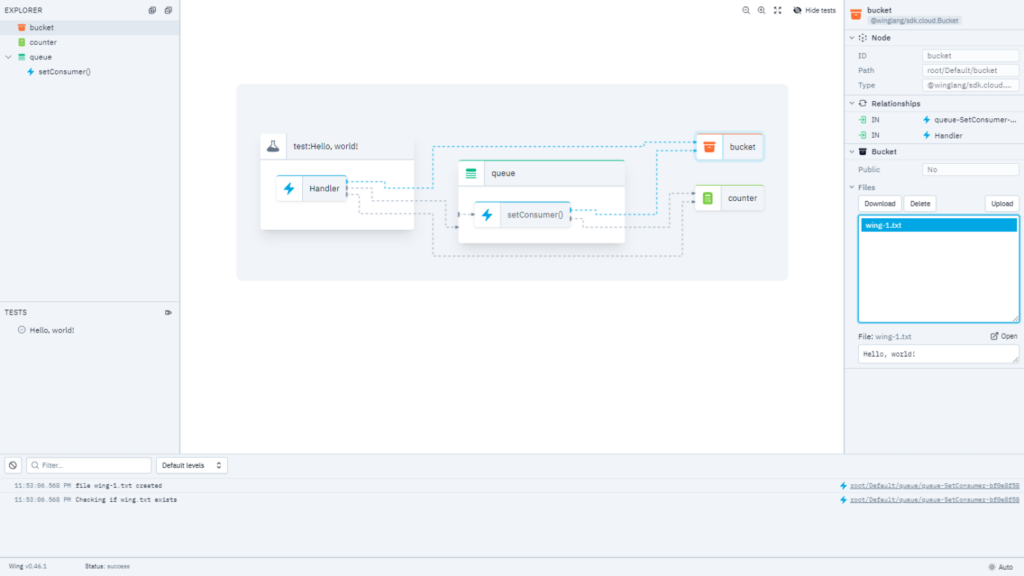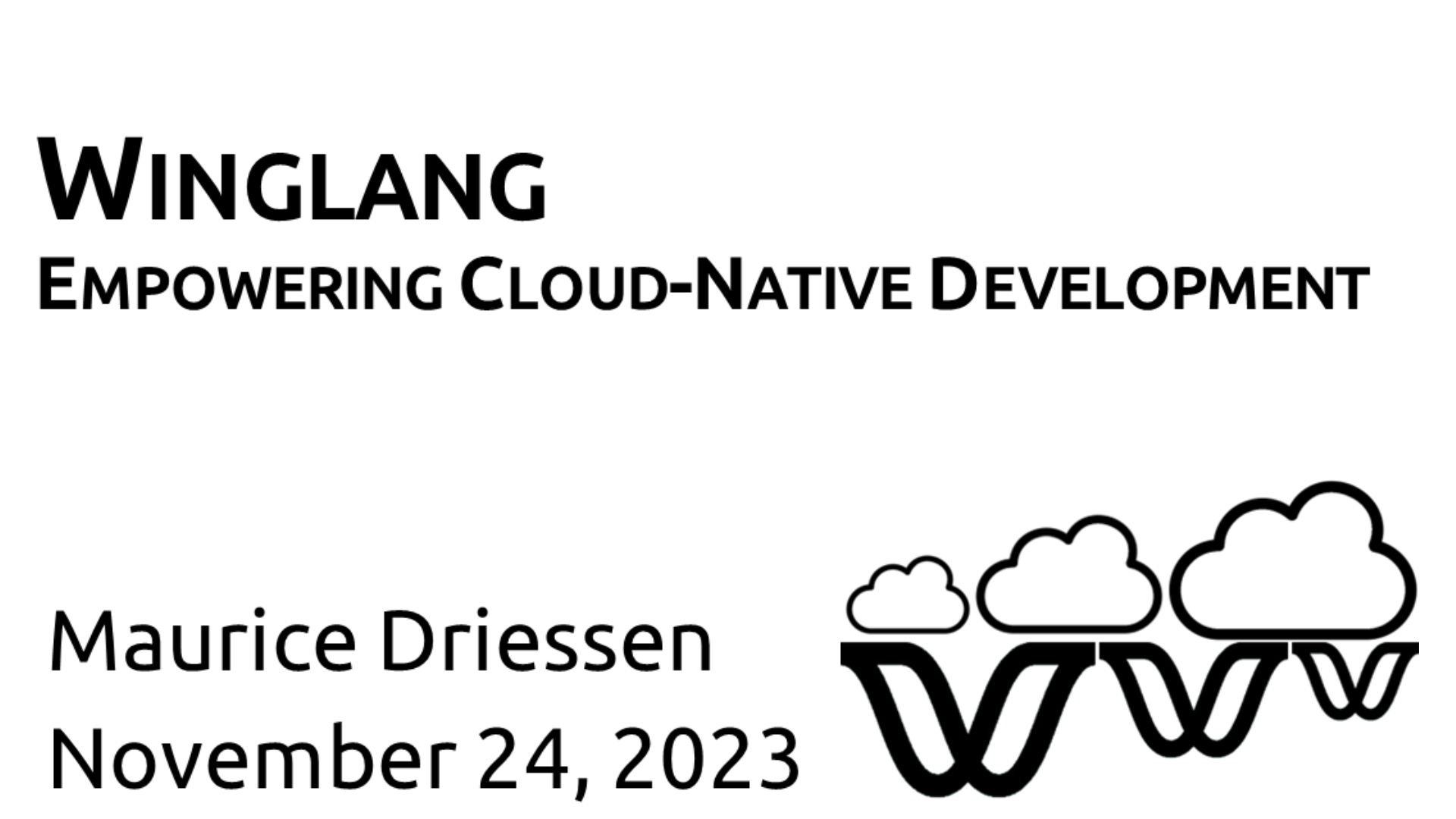Tired of the complexity and inefficiency of traditional programming languages for cloud development? In today’s rapidly evolving tech landscape, traditional programming languages like Java, C#, and Python have undeniably been the backbone of software development. However, with the advent of cloud computing and the demand for efficient cloud-native applications, the need for a new breed of programming language has become apparent. Enter Winglang, an open-source programming language meticulously crafted to thrive in the cloud era. Winglang is a new cloud-native programming language that makes cloud development more accessible, reliable, and cost-effective.
The Challenges of Traditional Programming Languages in the Cloud
While the programming languages we’ve cherished for years have shown their mettle in various domains, they are not inherently suited for the cloud environment. Cloud-native development brings unique challenges with regard to complexity, reliability, and cost. Cloud-native applications are inherently complex, with multiple components that need to work seamlessly. Traditional languages struggle to handle this complexity effectively and have the shortcomings when used for cloud-native application development:
- Low-level APIs: Traditional languages typically provide low-level APIs for interacting with cloud services. This can make it difficult to use these services effectively, and it can also lead to errors.
- Debugging: Traditional languages often lack built-in debugging tools and support for cloud-native applications, which can make debugging complex and time-consuming. Additionally, traditional languages may not provide a local simulation environment for the cloud infrastructure components declared in the code, which can make it difficult to test and debug cloud-native applications locally.
- Reliability: Traditional languages can exacerbate reliability issues due to their lack of support for cloud-native features, infrastructure provisioning and management not natively integrated in the development environment, and lack of visibility and control.
These shortcomings call for a cloud-oriented language. A “cloud-oriented language” is a programming language specifically designed or optimized for developing applications that leverage cloud computing principles and services. It typically includes features like seamless integration with cloud infrastructure, abstraction of underlying complexities, and tools for efficient development, testing, and deployment in cloud environments. The aim is to enhance the development and operational efficiency of applications in cloud-native architectures.
Introducing Winglang: The Future of Cloud-Native Development
Winglang, or Wing for short, isn’t just another programming language; it’s a game-changer for cloud-native development. Winglang is a new cloud-oriented open-source programming language that enables developers to build distributed systems that leverage cloud services as first-class citizens by combining infrastructure and application code in a safe and unified programming model. Wing programs can be executed locally using a fully-functional simulator, or deployed to any cloud provider.
Winglang addresses the pains of developing for the cloud by letting developers work at a higher level of abstraction and focus on business logic instead of cloud mechanics. It also provides a set of tools that let developers test their code locally, significantly faster than before. In short, Winglang is a new cloud-oriented programming language that makes it easier and faster to build and deploy reliable cloud-native applications.
What is a cloud-oriented language?
Winglang is what we call a cloud-oriented programming language. It allows developers to build distributed systems that fully leverage the power of the cloud without having to worry about the underlying infrastructure. It’s best explained through the “Hello, world!”-example:
bring cloud;
let queue = new cloud.Queue(timeout: 2m) as "queue";
let bucket = new cloud.Bucket() as "bucket";
let counter = new cloud.Counter() as "counter";
queue.setConsumer(inflight (body: str): str => {
let next = counter.inc();
let key = "myfile-${next}.txt";
bucket.put(key, body);
});In this simple application, every message that goes into the queue is written to a new object inside a cloud bucket. An atomic counter is used to generate an incrementing and unique key for each object.
But don’t let the simplicity of this example fool you!
The example shows how Wing’s pre-flight and in-flight concept is used to separate the infrastructure provisioning and management code from the application code. The pre-flight code, in the example the initialization of queue, bucket and counter, is executed once, at compile time, to generate the infrastructure configuration of the Wing application. The in-flight code, in the example the function queue.setConsumer() is executed at runtime to handle the application logic.
When compiling this code, the Wing compiler will produce a bundle of artifacts that are ready to be deployed to a cloud provider. This bundle includes Terraform files which define the infrastructure resources required for this application and JavaScript code to run on cloud compute resources.
When deployed to the cloud, this application can handle an infinite amount of traffic, with no need for you to explicitly take care of scaling, load balancing, security policies, or any other infrastructure-related concerns. For example, when targeting AWS, Wing will use Amazon S3 for the bucket, Amazon SQS for the queue, Amazon DynamoDB for the atomic counter, and AWS Lambda for the handler. It will also render least privilege IAM security policies, wire up environment variables and produce the code bundles needed for this to work on AWS Lamda.
Wing is also cloud agnostic. For example, the cloud.Queue resource used in the example can be backed by Amazon SQS, by Azure Queue Storage, or by RabbitMQ by CloudAMQP. The Wing compiler supports multiple compilation platforms. Each resource in the Wing ecosystem can support any number of backends.
Wing’s developer experience
Testing and debugging are essential for developing high-quality cloud-native applications. Winglang makes testing and debugging easy and efficient with its built-in testing framework and the Wing Console.
Winglang’s testing framework is lightweight and easy to use. It allows you to run the same tests in isolation on both the Wing simulator and in the cloud. This makes it easy to test your code thoroughly and identify any potential problems before you deploy your application. Here is a test for our “Hello, World!”-example:
test "Hello, world!" {
let fileindex = counter.peek() + 1 ;
queue.push("world!");
let filename = "wing-${fileindex}.txt";
let found = util.waitUntil(() => {
log("Checking if wing.txt exists");
return (filename);
});
expect.equal(bucket.get(filename), "Hello, world!");
}The Wing Console provides a user-friendly interface for debugging Winglang applications running on the local cloud simulator. The Console displays a hierarchical structure of the resources in your application, as well as an Application Map view that shows the relationships between the resources.

The Wing Console
When you click on a resource in the Explorer or Map view, the resource interaction panel on the right side of the Console will automatically update. This panel allows you to conveniently interact with the selected resource. For example, you can see the files in a bucket, upload, download, and delete files, and view and open file content.
With a primary focus on developer experience, the Wing Console aims to provide instant feedback to developers during the cloud application development process. Unlike traditional cloud development iterations that involve time-consuming deployments to the cloud, Wing and the Wing Console streamline this process, enabling cloud developers to swiftly receive immediate feedback on code changes directly on their local machines.
Key Features and benefits of Winglang
Winglang operates on three core principles:
- Infrastructure as Code: Developers can define and manage cloud infrastructure as code using the same language used for application code, simplifying the management of complex cloud architectures.
- Intent-Driven Programming: Winglang provides a high-level abstraction for cloud services, enabling developers to express their intent without getting bogged down by implementation details, thus speeding up development and reducing errors.
- Local Simulation: Winglang includes an in-built simulator for testing and debugging code locally, saving time, money, and streamlining development.
Wing simplifies complexity to make cloud development more accessible. This is accomplished through a unified programming model and a built-in simulator, alleviating the necessity for developers to delve into intricate cloud concepts. Wing elevates cloud application reliability through intent-driven programming, reducing errors and ensuring consistent application behavior. Cost control in cloud development is a priority for Wing, achieved by emphasizing productivity and efficiency. This includes built-in testing and debugging tools for the simulated local environment, along with support for declarative infrastructure provisioning.
Winglang offers numerous advantages over traditional languages for cloud-native development. In terms of productivity, Winglang streamlines the development lifecycle, markedly reducing the time and effort required for the construction and deployment of cloud applications. In the arena of reliability, Winglang introduces a unified programming model that serves as a robust safeguard, minimizing the likelihood of errors and enhancing the overall dependability of cloud applications. Moreover, with a keen eye on economic efficiency, Winglang contributes to cost reductions by accelerating development processes, thereby mitigating the overall expenses associated with cloud development.
Looking Ahead
Wing is presently in its pre-release phase, characterized by its youthfulness and relative naivety. Actively undergoing development, it’s important to note that, at this juncture, you must not consider it a fully matured or extensively useful tool for production purposes. The ongoing development means that APIs and language features are subject to changes in the upcoming months. It’s prudent to acknowledge that there might be instances of missing components, rough edges, performance issues, and, yes, the occasional bug.
However, Winglang is more than just a promising language; it’s the catalyst for a new era in cloud-native development. With its unique features, it is poised to make cloud development more accessible, efficient, and reliable. Winglang is clearly tailored for the cloud-native world, offering features that traditional languages lack. Its community support is on the rise, marking it as a language to watch in the coming years. Keep an eye on this language as it reshapes the future of cloud-native programming.
In conclusion, Winglang emerges as a formidable player in the realm of cloud-native development, addressing the inherent challenges faced by traditional languages with ingenuity. From its streamlined development process and unified programming model to the Wing Console facilitating seamless testing and debugging, Winglang stands as a promising solution for building reliable cloud-native applications. As we anticipate future developments.
Sources:
Wing Programming Language Reference
A quick introduction to Winglang by Elad Ben-Israel on YouTube
Winglang on GitHub

